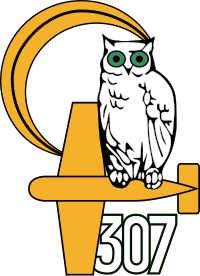No. 307 Polish Fighter Squadron

307 Squadron Logo
|
|
| Active | 24 August 1940 – 2 January 1947 |
|---|---|
| Country |
|
| Allegiance |
|
| Branch |
|
| Role | Night fighter |
| Size | squadron |
| Part of | RAF Fighter Command |
| Nickname(s) | Eagle-owls |
| Commanders | |
| Notable commanders |
Stanisław Grodzicki |
| Insignia | |
| Squadron Codes | EW (Aug 1940 – Jan 1947) |
No. 307 (City of Lwów) Polish Night Fighter Squadron (Polish: 307 Dywizjon Myśliwski Nocny "Lwowskich Puchaczy" ) was a Polish night fighter squadron formed in Great Britain on 24 August 1940 following an agreement between the Polish Government in Exile and the United Kingdom. It was the only Polish night fighter squadron fighting alongside the Royal Air Force during World War II. 307 Squadron is named after the Polish city of Lwów, and nicknamed "Eagle Owls".
The nickname "Eagle Owls" comes from fighters who defended Lwów (now Lviv; German: Lemberg) in Galicia, Poland from invading Ukrainian forces in the Polish-Ukrainian War of 1918–1919, who were referred to as the Lwów Eaglets (Polish: Orlęta Lwowskie). The nickname is also appropriate to a night fighter squadron, as the eagle owl is a predator that flies at night.
After its formal formation in Blackpool on 24 August 1940 No. 307 squadron was assembled at RAF Kirton-in-Lindsey on 5 September 1940 as a night fighter unit, flying the Boulton Paul Defiant turret-fighter and took up residence at RAF Jurby, Isle of Man. An example of the Boulton Paul Defiant, with serial number N1671, EW-D, the sole complete surviving Defiant is to be seen on display at the RAF Museum at RAF Hendon. In August 1941 the squadron converted to Beaufighters which it flew until being re-equipped with Mosquitoes in late 1942.
...
Wikipedia
